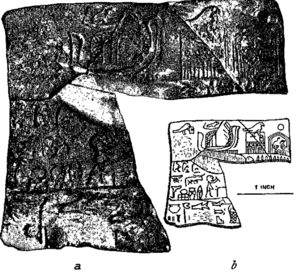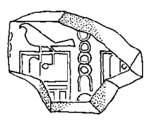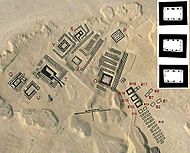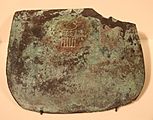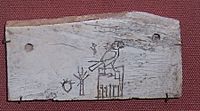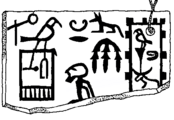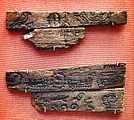Hor-Aha facts for kids
Quick facts for kids Hor-Aha |
|
|---|---|
| Aha | |
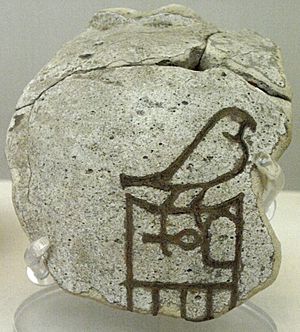
Faience vessel fragment with serekh inscribed with the Horus-name "Aha", on display at the British Museum.
|
|
| Pharaoh | |
| Reign | 31st century BC (1st Dynasty) |
| Predecessor | Narmer |
| Successor | Djer |
| Consort | Benerib, Khenthap |
| Children | Djer |
| Father | Narmer ? |
| Burial | Chambers B10, B15, B19, Umm el-Qa'ab |
Hor-Aha, also known as Aha, was an ancient Egyptian pharaoh. Many experts believe he was the second ruler of Egypt's First Dynasty. He lived around 3100 BC and likely ruled for a long time. Some historians think he might have been the legendary Menes, who is often credited with uniting Egypt. However, most evidence suggests that Narmer was the pharaoh who first brought Upper and Lower Egypt together.
Contents
Who was Hor-Aha?
His Name
The name Hor-Aha comes from his Horus-name. This special name was linked to the god Horus. Horus-Aha means "Horus the Fighter."
Ancient Egyptian pharaohs had several names. One was the Horus-name, used in official records. Another was the nebty-name, which appeared in king lists like the Turin and Abydos lists. Experts like Flinders Petrie helped connect these different names. They believe Hor-Aha (from archaeological finds) is the same person as Ity (from historical lists).
This research also helped identify Menes (a nebty-name) with Narmer (a Horus-name). Both are known for uniting Egypt and being the first pharaoh of the First Dynasty. Hor-Aha is usually seen as Narmer's successor.
Different Ideas About Hor-Aha
There are different ideas about Hor-Aha's true identity. Some believe he was the same person as the famous Menes. They think he was the one who united all of Egypt.
However, other historians believe Hor-Aha was the son of Narmer. Narmer is widely recognized as the pharaoh who first united Egypt. Evidence like the Narmer Palette supports this. Most experts now agree that Narmer united Egypt, and Hor-Aha was his son and heir.
Hor-Aha's Time as Pharaoh
Taking the Throne
Archaeological finds, like seal impressions from the tombs of Den and Qa'a, show Hor-Aha was the second pharaoh of the First Dynasty. His father, Narmer, had already joined Upper Egypt and Lower Egypt into one kingdom. Hor-Aha likely became pharaoh around the mid-31st century BC.
What He Did in Egypt
Hor-Aha was involved in many religious activities. Records show he visited a shrine of the goddess Neith in Sais, located in the Nile Delta. Also, the first known image of the sacred Henu-boat of the god Seker was found from his reign.
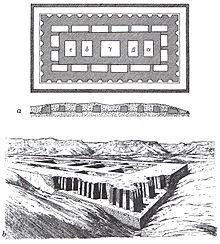
Queen Neithhotep likely died during Hor-Aha's reign. He arranged for her burial in a grand mastaba (a type of ancient Egyptian tomb) in Naqada. Many believe Neithhotep was Hor-Aha's mother. Her burial in Naqada suggests she came from that area. This might mean Narmer married someone from Naqada's royal family to strengthen his rule. However, a recent discovery in 2016 showed that Neithhotep was a queen regent for Hor-Aha's successor, Djer. This means she lived during Hor-Aha's reign but continued to be important into Djer's time.
During Hor-Aha's rule, the oldest mastaba in the North Saqqara burial ground near Memphis was built. This tomb belonged to an important government official, possibly a relative of Hor-Aha. This shows that Memphis was becoming a very important city during his reign.
Activities Outside Egypt
An ivory tablet from Abydos suggests that Hor-Aha led a military trip against the Nubians. A year tablet from his reign is even called "Year of smiting of Ta-Sety," which means "Year of defeating Nubia."
During Hor-Aha's time, trade with the Southern Levant (modern-day Israel, Palestine, Lebanon, Jordan) seemed to slow down. Unlike his father Narmer, Hor-Aha is not found in records outside the Nile Valley. This might mean Egyptians started using their own resources more, rather than relying on long-distance trade. However, an Egyptian outpost at En Besor was active during his reign. Other Egyptian settlements were also active in places like Byblos and along the Lebanese coast. Hor-Aha's tomb also contained pieces of pottery from the Southern Levant.
Hor-Aha's Family
Hor-Aha's main wife was Benerib. Her name was found with his on several historical items, especially from tomb B14 at Abydos, Egypt. This tomb is right next to Hor-Aha's own burial place.
Hor-Aha also had another wife named Khenthap. She was the mother of his son, Djer, who later became pharaoh. Khenthap is mentioned as Djer's mother on the Cairo Annals Stone.
His mother is believed to be Neithhotep. She was also thought to be the wife of Narmer.
Hor-Aha's Tomb
Hor-Aha's tomb is located in the royal burial ground of the First Dynasty kings at Abydos, known as Umm el-Qa'ab. His tomb has three large rooms (called B10, B15, and B19). These rooms are right next to Narmer's tomb. They are rectangular and dug directly into the desert floor, with walls made of mud bricks.
Narmer's tomb only had two rooms, but Hor-Aha's had three larger, separate rooms. This was because it was hard to build very large ceilings back then. Wood for these big roofs often had to be brought in from far away lands like Canaan.
A new thing seen in Hor-Aha's tomb was that some members of the royal household were buried near the pharaoh. It was a custom for some people and animals to be buried near the pharaoh, including servants, dwarfs, women, and even dogs. A total of 36 smaller burials were found in rows near Hor-Aha's main tomb. As a sign of his royal power, Hor-Aha was even buried with a group of young lions.
Images for kids
-
Copper tool bearing the serekh of Hor-Aha, on display at the Egyptian Museum of Berlin.
-
Fragmented ebony label of Hor-Aha showing a visit of the king to the shrine of the goddess Neith of Sais in the Delta, British Museum.
See also
 In Spanish: Aha para niños
In Spanish: Aha para niños


